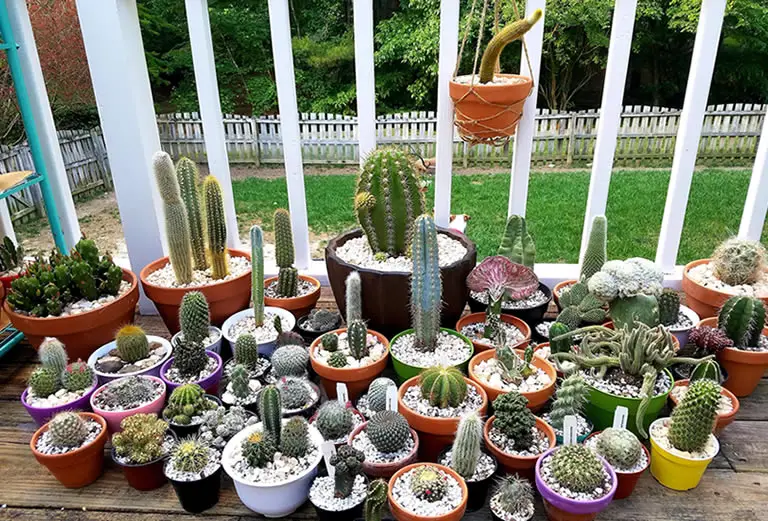Cacti are the ultimate low-maintenance houseplants. Built to survive harsh deserts and intense sun, these resilient plants require very little water, adapt well to indoor life, and reward growers with bold shapes, striking textures, and even the occasional bloom. With just a little attention to their light, soil, and watering needs, cacti can thrive for years and become living sculptures in your home.
Here’s everything you need to know to keep your cactus happy, whether you’re growing a single specimen on a windowsill or filling a shelf with a collection of prickly personalities.
Table of Contents
Cactus (Cactaceae)
Cactus plants belong to the family Cactaceae, which includes over 1,700 species.
Most cacti are native to the Americas, particularly arid regions of Mexico, the southwestern United States, and parts of South America.
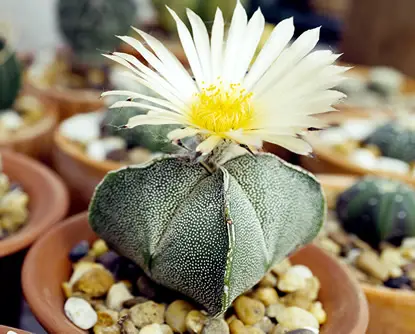
A few even grow in rainforests, such as the epiphytic Rhipsalis species.
These plants have evolved to store water in their thick stems, often losing or modifying their leaves into spines to reduce moisture loss and protect against animals.
Their waxy skin helps prevent evaporation, and many species are covered in areoles—small, round bumps that grow spines, flowers, or new branches.
Despite their rugged origins, most cacti adapt surprisingly well to indoor life.
With a little care, they can live for decades and grow into beautiful, sculptural specimens.
Light Requirements: Bright Light or Bust
Cacti crave sunlight. Most indoor varieties need at least 4 to 6 hours of direct sunlight per day to stay healthy.
A south- or west-facing window is usually best.
If you don’t have enough natural light, consider supplementing with a grow light.
Without proper lighting, many cacti will become pale, thin, or stretched—what growers call “etiolated.”
Rotate your cactus every few weeks so all sides get even light exposure and the plant grows straight.
Watering: Less Is More
Cacti are drought specialists and should only be watered when the soil is completely dry.
In most indoor environments, this means watering every 2–4 weeks, depending on light and temperature.
When you do water, soak the soil thoroughly until water drains from the bottom, then allow the soil to dry fully before watering again.
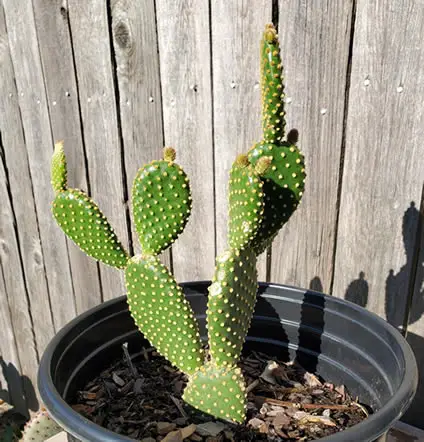
Never leave your cactus sitting in water.
During the cooler months, reduce watering even further as most cacti enter a dormant or slow-growth phase.
Soil and Potting: Fast Drainage Is Key
Cactus roots are highly sensitive to excess moisture, so soil with excellent drainage is essential.
Use a commercial cactus mix like this one, or make your own by combining potting soil with coarse sand, perlite, or pumice.
Choose a pot with drainage holes, and avoid decorative containers that trap water. I prefer to use terracotta pots for larger succulents.
Unglazed terracotta pots are ideal because they allow the soil to dry out faster.
Repotting is only needed every 2–4 years or when the cactus outgrows its container.
Fertilizer: Feed Lightly in Spring and Summer
During the growing season, you can feed your cactus once a month with a diluted cactus-specific liquid fertilizer like this one, or a balanced low-nitrogen formula such as 5-10-10 like this one or 2-7-7 like this one.
Too much nitrogen can cause soft, weak growth and reduce flowering.
Always water before feeding and avoid fertilizing in fall and winter.
Best Spot in the Home
Cacti love sunny windowsills, especially those facing south or west.
They also do well in bright living rooms, sunrooms, or under grow lights.
Smaller cacti look great in groupings or minimalist arrangements, while tall columnar types can become eye-catching floor plants near a bright window.
Outdoor Cactus Care
If you live in a warm, dry climate (Zones 9–11), many cactus species can be grown outdoors year-round.
Even in cooler climates, cacti can spend spring and summer outside.
Place your cactus in a sunny, sheltered spot, gradually increasing its exposure to full sun over a few days to prevent sunburn.
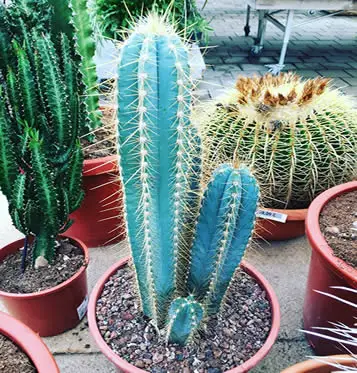
Be sure the container has excellent drainage, and move it indoors when nighttime temperatures drop below 50°F (10°C).
Hardy species like Opuntia (prickly pear) can survive outdoors in freezing temperatures if planted in the ground with sandy, fast-draining soil.
Popular Cactus Houseplants
Here are ten of the most popular cactus varieties for indoor growing:
1. Bunny Ear Cactus (Opuntia microdasys)
Small, oval pads covered in tiny fuzzy spines (glochids).
Cute and compact, but not touchable.
2. Golden Barrel Cactus (Echinocactus grusonii)
Globe-shaped cactus with golden-yellow spines.
Slow-growing but highly decorative.
3. Christmas Cactus (Schlumbergera x buckleyi)
A tropical cactus that blooms in winter with pink or red flowers.
Prefers indirect light and more moisture than desert types.
4. Old Lady Cactus (Mammillaria hahniana)
Covered in white hairs and pinkish spines, it often forms small clumps and may produce pink flowers in a ring around the top.
5. Moon Cactus (Gymnocalycium mihanovichii grafted)
Brightly colored tops (red, yellow, or orange) grafted onto a green rootstock.
Loved for its bold appearance.
6. Star Cactus (Astrophytum asterias)
Flattened, spineless cactus with a star-like shape and tiny white dots.
Very slow-growing but striking.
7. Blue Torch Cactus (Pilosocereus pachycladus)
Tall, columnar cactus with blue skin and woolly areoles.
Adds height and a cool tone to cactus displays.
8. Fairy Castle Cactus (Acanthocereus tetragonus ‘Fairy Castle’)
Multiple columnar stems form a castle-like structure.
Very popular with beginners and grows slowly indoors.
9. Peanut Cactus (Echinopsis chamaecereus)
Trailing stems resemble peanuts and produce bright orange flowers in spring.
10. Bishop’s Cap (Astrophytum myriostigma)
Symmetrical, star-shaped cactus with few or no spines.
Easy to care for and grows well in bright windows.
Common Problems and Fixes
Shriveled or wrinkled stems
Usually a sign of underwatering or root issues. Water thoroughly and make sure the pot drains well.
Soft, mushy base or black spots
Overwatering or rot. Cut away affected tissue and let the plant callous.
Repot in dry soil and reduce watering.
Pale or stretched growth
Not enough light. Move the plant to a brighter location or use a grow light to supplement.
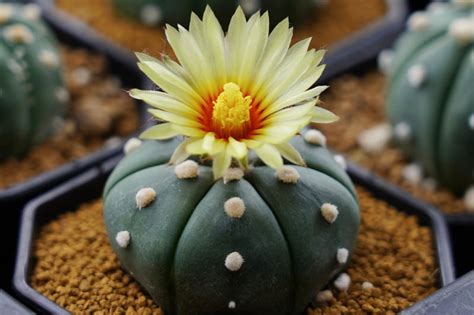
Sunburn (white or brown patches)
Caused by sudden exposure to direct sun.
Gradually acclimate indoor cacti to brighter light when moving them outside.
No flowers
Most cacti need bright light and a cool, dry winter rest to bloom.
Ensure proper seasonal care and be patient—many species take years to flower indoors.
Final Thoughts
Cacti are perfect plants for anyone who wants beauty, structure, and minimal effort.
With the right light, well-draining soil, and a careful hand on the watering can, these sculptural succulents will thrive for years and become a standout part of any plant collection.
Whether you’re a complete beginner or building out your desert-inspired display, there’s a cactus out there that’s ready to grow with you.

